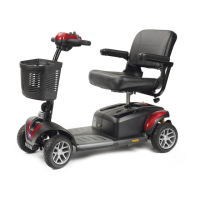
Do you have a question about the TGA Zest and is the answer not in the manual?
Details the TGA Zest as a class 2 mobility scooter for indoor/outdoor use, its folding capability, speed, and slope negotiation.
Introduces the control panel of the scooter with labeled components (A, B, C, D, E).
Press the horn button to sound your horn.
Insert and rotate the key clockwise to power on, anti-clockwise to turn off.
Shows battery charge level with blocks illuminating from red to green. Loss of blocks indicates decreasing charge.
Allows pre-selection of maximum speed by turning an adjuster knob clockwise to increase speed.
Controls the speed of the scooter; pushing further increases speed.
Emphasizes responsible driving, awareness of pedestrians, and potential hazards like children and elderly people.
Clarifies that the scooter is a Class 2 mobility scooter and not road legal.
Instructions on how to adjust the tiller position using the hand wheel located at its base.
Details on how to lift the battery pack up and away from the scooter base using the provided handle.
Lift upwards to rotate the seat left or right with locking positions at 45° intervals.
Instructions on lifting armrests up/down and removing them by turning a hand wheel.
Steps to remove the seat by lifting the base up and away from the scooter using the swivel lever.
Steps to dismantle the scooter, including removing the seat, battery pack, and subframe.
Instructions for reassembling the scooter, including reconnecting the tiller, subframe, battery pack, and seat.
Information on the manual parking brake release lever located at the rear of the scooter.
Guidance on cleaning the seat upholstery using a damp cloth and mild soap, avoiding chemicals and UV light.
Instructions for cleaning the scooter's plastic bodywork with soapy water and car polish, avoiding harsh cleaners.
How to check the motor brake functionality by attempting to push the scooter when it's off or in neutral.
Provides solutions for common issues like the scooter not starting, not charging, or battery indicator problems.
Advice on scooter usage, road legality (Class 2 vs. Class 3), and general user tips.
Discusses insurance considerations for fire, theft, damage, and third-party liability.
Recommends considering a breakdown and recovery service for peace of mind.
Highlights the importance of carrying a mobile phone for communication during emergencies.
Guidance on how to carry loads to maintain scooter stability and range, avoiding overloading.
Information on carrying sealed lead-acid batteries on aeroplanes and airline compliance certificates.